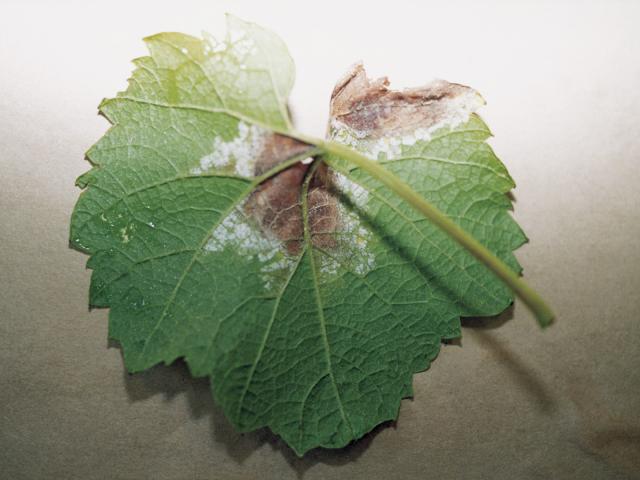Symptoms
Downy mildew attacks all green parts of the grapevine.
Leaves
The symptoms vary with leaf age. On young leaves (in spring), the disease will appear on the upper surface as small yellow spots referred to as oil spots. They are about 10mm diameter, often with a chocolate halo (Figures 1 and 2). These spots tend to grow to about 50mm diameter as they mature and the halo fades. As they enlarge they may appear to cover most of the leaf, especially if there is more than one spot on the leaf (Figure 3). On red varieties the oil spot can appear red (Figure 4).
After warm humid nights, a dense, raised, white cottony growth develops on the underside of the yellow oil spots (Figure 5). This is commonly referred to as 'white down'. As the spots age naturally, or after a sporulation event (see later) or hot weather, their centres dry out and become a reddish brown leaving an outer ring of yellow (Figure 6).
The fungus in this yellow ring remains active and given favourable conditions at night, can produce a ring of 'white down' on this outer active edge (Figure 7).

Later in the growing season (late summer and autumn) on mature leaves, leaf infections will appear as small, angular, yellow spots that are limited in growth by veins (Figure 8). These form a tapestry-like (mosaic) pattern that soon turn reddish brown. Defoliation can occur in severely affected vines.
Shoots
Infection on young shoots, stems and tendrils is seen as oily brown areas (Figure 9). These oily patches may spread into leaf stalks, which turn brown and may die. After warm humid nights these oily patches may also sporulate and be covered with white down.
Inflorescences, bunches and berries
Infection on inflorescences, young berries and bunches are seen as oily brown areas. After suitable warm humid nights they may be covered with white down (Figure 10). Infected inflorescences and young bunches rapidly turn brown and wither (Figure 11). Infected young berries stop growing, harden and may later develop a purple hue. They turn dark brown, shrivel and fall from bunches.
Berries become resistant to infection when they are pea size (5-6mm diameter). However, they may still be killed if the berry or bunch stems become infected. They may also sunburn and fail to ripen if defoliation occurs from leaf infection (Figure 12).
